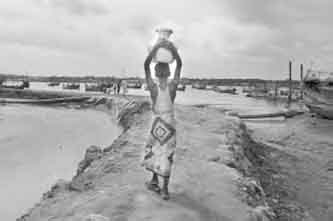
Drinking water scarcity among S-W climate vulnerable people
Mohammad Alamgir | Saturday, 25 January 2014

Home to approximately 160 million people, Bangladesh is struggling to sustain an adequate level of quality freshwater to make available for the people. Unlike other water-scarce countries, Bangladesh is generously endowed with freshwater tributaries and distributaries that generally make for a healthy water ecosystem. However, flooding and coastal deterioration caused from climate change, and water contaminations have resulted in a water crisis for the people particularly for the women and children of southwest Bangladesh. Climatic consequences disorders contribute salinity intrusion in coastal areas resulting in water contamination. Worsening weather extremes that bring floods, storm surges and cyclones are also contributive to increased salinity. After the devastating cyclone Aila that struck Bangladesh's southwestern coastal belt in May 2009, locals face difficulties and are suffering from sufficient drinking water since the cyclone damaged most of the sources of fresh water. In the cyclone affected areas, installation of tube wells turned to be a tough job due to the alarming presence of salinity. Oxfam report illustrates that approximately 34 per cent of households still do not have access to safe drinking water in the cyclone affected areas of southwest Bangladesh. Renowned climate scientist Dr Ainun Nishat says, "Salinity in the water of coastal areas has now reached over 20 parts per thousand, but the human body can only tolerate five parts per thousand." (The Guardian, May 7, 2013).
People of the locality are suffering most. Particularly, the condition of women and children in collecting and utilising water is even worse. Women in coastal areas need to go miles to collect a pitcher of safe drinking water which have been a nightmare for them in most cases. Acute scarcity of safe drinking water results in poor health, social stigma and bad financial implications. People in this region suffer from various diseases caused by drinking water with high level of salinity, impurity or arsenicosis. Various skin diseases, intestinal diseases, dysentery, fever and diarrhea are part of their life. Other health concerns linked to a lack of safe drinking water include malnutrition amongst women and children, reproductive problems for pregnant women, skin turning black, physical weakness and anxiety. Women can be particularly susceptible to diseases (e.g. rickets) as they are expected to take less water than men. (Sayeeda Farhana, PPDM, BRAC University, 2011).
Several social crises associated with poor access to safe drinking water are resulting in the education of children which includes young children are often left unattended when their mother goes to fetch water. The most alarming factor is that women are teased and harassed on their way to fetching water; social stigma prevents girls getting married and finally local contentions and litigations related to water use have become common phenomena.
Considering acute scarcity and hence in order to ensure safe drinking water as well as reduce the suffering of the people, women and children in particular of southwestern Bangladesh, a joint and collective effort both from the Government and NGOs is an urgent need .
Government through Local Government and Engineering Department (LGED) and Directorate of Public Health and Engineering (DPHE) has to play the role of a catalyst and should be able to understand their roles and responsibilities in ensuring safe drinking water in this locality. Union Parishad (UP), the lowest tier of Bangladesh's local government, should also be held responsible since the local government representatives are mandated for the betterment of locals. But, in reality, this institution lacks capacity, appropriate knowledge and latest technology and the ability to mobilise local resources to effectively deal with the problem. NGOs and other institutions should come forward for enhanced knowledge sharing and active participation to make the duty bearers accountable. They can increase and reinforce knowledge on climatic hazards on safe drinking water particularly for the women and children. Mass media can also play a vital role and can help to create an enabling environment for behaviour change, and community mobilisation and social dialogue to heighten the sustainability of these changes at the grassroots. But, this problem will not be addressed properly until the people who suffer most and are facing many odds, are involved with the initiative. A stronger and solid partnership can be of great help for effective implementation of safe drinking water campaign across government, media and civil society organisations. Local organisations viz Pani Committee can play the role of a pressure group and could facilitate local level dialogue and mobilise and aware local people.
Through a collective effort and spontaneous involvement of all stakeholders particularly the Government, the people of the locality can get enough and sufficient amount of safe drinking water by which they can lead a peaceful and dignified life.
The writer is a development communications professional and can be reached at mohammad.alamgir@islamicrelief-bd.org